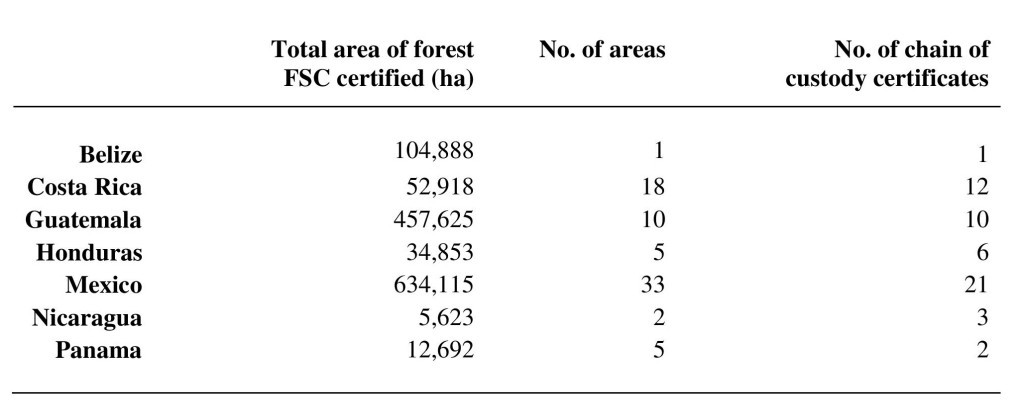This figure is referred to in the book as Table 6.2 (Page 124)
Timber certification is a relatively recent phenomenon which sprang from rising concerns about tropical deforestation. The movement gathered momentum during the 1980s and 1990s which saw a number of campaigns against unsustainable logging from Western environmental NGOs (such as Friends of the Earth and Earth First!), direct-action protests and consumer boycotts.[1]
There are currently a number of certification schemes, of which the Forest Stewardship Council (FSC) is the most widely implemented on a global scale. FSC is an independent, non-governmental organisation founded in 1993 to provide a means of certifying and labelling forest products which originate from responsible forest management. The idea is that customers will pay higher prices for sustainably produced timber products, and that this purchasing power will stimulate a transition to more sustainable forest management practices.
The simplicity of using a market mechanism to address global forest degradation is enticing. Its supposed advantage is that it compensates for the inherent difficulties associated with regulation in developing countries, and bypasses intergovernmental efforts which may be slow and ineffective. Regulation is also hardly viewed favourably against a backdrop of neo-liberal and free-trade principles dominating the current global economic model (see Ch. 7). William Adams suggests that unwillingness to regulate trade on environmental grounds and support for neo-liberal policies has restricted the WTO’s ability to advance sustainable forestry.[2] However, of course the existence of a market for certified timber does not eradicate unsustainable forestry activity or illegal logging.
Despite the certification model proliferating in Europe and North America, there has been limited success in most developing countries.[3]The number and total areas of FSC certified forests and numbers of chain of custody certificates (to businesses or operations handling FSC certified products) in the Central American countries are as follows:[4]

The international timber trade is much less important in Latin America than in other parts of world such as South East-Asia and the majority of wood is harvested for domestic use. A report for the United States Agency for International Development acknowledged that “despite the increased interest in forestry certification in Central America and Mexico, a reality is that many of the companies or certified forestry projects have not in fact managed to introduce their products to the international market with any success.”[5]
One solution is to increase trade for the regional market. WWF Centroamérica, recognising the potential in the sizeable internal timber trade, campaign to increase awareness of FSC certification, and particularly to promote the use of certified timber to construction companies, architects and hotels in Nicaragua and Costa Rica.[6]
The pervasiveness of illegal logging throughout Central America is a critical problem for timber certification, as it injects an abundance of low-cost wood into the market, undermining the economic viability of certified products.
The cost of certification is a pertinent issue, as it penalises small-scale producers. It is often noted that the economic incentives are not great enough to induce most forest producers to switch to sustainable methods.[7] FSC have attempted to address this problem by introducing ‘group certification’ and new standards for small and low-intensity managed forests (SLIMFs) which are more sensitive to local contexts.
Other challenges which limit the scope of forest certification in Central America, and in developing countries in general include land tenure insecurity, limited business experience and technical capacity of local operators, and inability to meet international demands in terms of consistent quality, type and quantity of timber.[8]
Duncan Macqueen of the IIED (International Institute for Environment and Development) has highlighted the flaws of the FSC scheme –in accommodating for mostly large producer industries who can absorb the costs of certification, failing to differentiate small-scale community enterprises, and failing to guarantee the latter group a fair price. He argues that a marriage between FSC and the fair-trade movement may provide the answer; that a collaboration between FSC and Fair Trade Labelling Organizations International (currently in discussion) could empower small-scale community forestry projects, delivering on both social and environmental goals through reducing poverty and sustaining forests. [9]
[1] Adams, W. M. (2009) Green Development: Environment and sustainability in a developing world, 3rd edition, Routledge, London
[2]Ibid
[3] Cashore, B., Gale, F., Meidinger, E. and Newsom, D. (2006) Confronting sustainability: Forest certification in developing and transitioning countries, Yale School of Forestry and Environmental Studies, New Haven, USA
[4] Forest Stewardship Council (2009) ‘Global FSC certificates: type and distribution’ (June) http://www.fsc.org/fileadmin/web-data/public/document_center/powerpoints_graphs/facts_figures/09-06-15_Global_FSC_certificates_-_type_and_distribution_-_FINAL.pdf (accessed 26 August 2009)
[5] International Resources Group Ltd (1999) ‘Improving market access for certified forest products in Central America and Mexico’ (April) http://pdf.usaid.gov/pdf_docs/PNACE758.pdf (accessed 26 August 2009)
[6] See the WWF Centroamérica website: http://www.wwfca.org
[7] Gullison, R. E. (2003) ‘Does forest conservation conserve biodiversity?’ Oryx, 37: 153-6
[8] Op.cit. (Cashore et al.; InternationalResources Group Ltd)
[9] See Macqueen, D. J., Dufey, A. and Patel, B. (2006) Exploring Fair Trade Timber: A review of issues in current practice, institutional structures and ways forward. IIED Small and Medium Forestry Enterprise Series No.19. IIED, Edinburgh, UK; also Macqueen, D.J (2008) ‘A cut above: building the market for fair trade timber’ Sustainable Development Opinion, International Institute for Environment and Development (February)